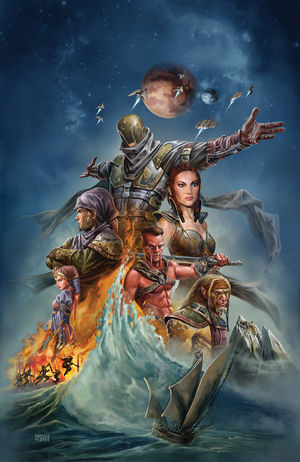This week’s Star Wars comic is the long-awaited first issue of John Ostrander’s and Jan Duursema’s new series, Dawn of the Jedi and GONK has your spoilery review.
It’s here! Issue #1 of Dawn of the Jedi is out this week. Putting the “long, long, long, long time ago” into the galaxy far, far away, we are introduced to a new era in the Star Wars timeframe, before the Jedi and Sith emerge as opposing forces.
 This first issue of the series, starting the ‘Force Storm’ story arc, is one half history lesson and one half plot kickstarter. The first half of the issue is an in-story telling of the history of the Je’Daii from a master to some younglings: how the Tho Yor ships brought sentient species (Human, Selkath, Wookiee, Twi’lek, etc.) from across the galaxy to Tython and the Force, and how they formed the Je’Daii, and later how their non-Force sensitive offspring colonized the other worlds of the system, eventually resulting in the recent Despot War between Queen Hadiya and the Je’daii. The second half introduces Predor Tul’kar, a Rakatan conquistador, and his Force Hound, the masked Force-sensitive hunter Xesh, as they conquer the Kumumgah on the lush world of Tatooine. Recalled to the Rakatan capital before being able to collect the slave spoils of their victory, Tul’kar confronts his superior, Predor Skal’nas. After letting their respective Force Hounds battle over who is better, Skal’nas lets Tul’kar and Xesh take the challenge of finding and claiming a Force-rich world in the hard-to-navigate Deep Core.
This first issue of the series, starting the ‘Force Storm’ story arc, is one half history lesson and one half plot kickstarter. The first half of the issue is an in-story telling of the history of the Je’Daii from a master to some younglings: how the Tho Yor ships brought sentient species (Human, Selkath, Wookiee, Twi’lek, etc.) from across the galaxy to Tython and the Force, and how they formed the Je’Daii, and later how their non-Force sensitive offspring colonized the other worlds of the system, eventually resulting in the recent Despot War between Queen Hadiya and the Je’daii. The second half introduces Predor Tul’kar, a Rakatan conquistador, and his Force Hound, the masked Force-sensitive hunter Xesh, as they conquer the Kumumgah on the lush world of Tatooine. Recalled to the Rakatan capital before being able to collect the slave spoils of their victory, Tul’kar confronts his superior, Predor Skal’nas. After letting their respective Force Hounds battle over who is better, Skal’nas lets Tul’kar and Xesh take the challenge of finding and claiming a Force-rich world in the hard-to-navigate Deep Core.
And with that, we see the players: the Je’daii monks on Tython, the other worlds of the system, still smarting from the war, and now the hungry Rakatans, looking to find Tython for their own Infinite Empire. If you’re not familiar with the Rakatans, their leftover Star Forge devices form the key macguffin in the Knights of the Old Republic game series, and the player comes across some of their history throughout the game. Also pulled from the game are the semi-aquatic species of Selkath from Manaan, which we really haven’t seen pulled into the EU much, until now.
The use of the storytelling to set the Tythan’s history works well (similar to the exposition-giving at the start of Serenity with the teacher and the students), and gives Jan Duursema some awesome panels depicting the coming together of the different species, the formation of Je’Daii society, etc. Duursema really nails the depiction of so many different species types: Wookiee, Selkath, Twi’lek, Rakatan, Zabrak, human, Kumumgah, and whatever Trill, Skal’nas’ Force Hound is (human or near-human). Not only are the characters seeming as individuals, they also show their emotions. With the combat of Trill and Xesh, we get a little bit of action, though it is more a tease of a rivalry that I’m sure will continue to build for a spectacular showdown later. I’ve been a big fan of the Ostrander/Duursema team since their work on Republic, so I expect a lot from this series, and so far, it’s off to a good start with both story and art.
As with other recent first issues from Dark Horse, there are two covers for this issue – Jan Duursema’s cover has Xesh with the Tho Yor ships in the background. While Xesh looks good in this piece, I’m a little disappointed in his appearance elsewhere – maybe his plain round helmet mask is too plain and dull compared to his armor. But he is a man of mystery. Gonzalo Flores has the variant cover, which is an ensemble of characters, lorded over by Xesh, but really highlighting the pre-modern look and feel of the era in the costumes.
With this first issue serving as a fine introduction, I’m not really sure why they needed to make the guidebook issue #0 (see my review on that), since Issue #1 creates a solid picture, perhaps not as detailed, but perhaps more relevant to the story as it is starting. My advice, if you haven’t jumped in already: just start with #1, and skip #0 (or buy it to complete your collection).